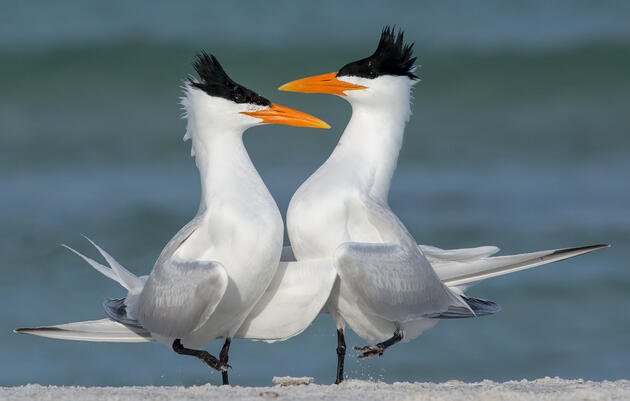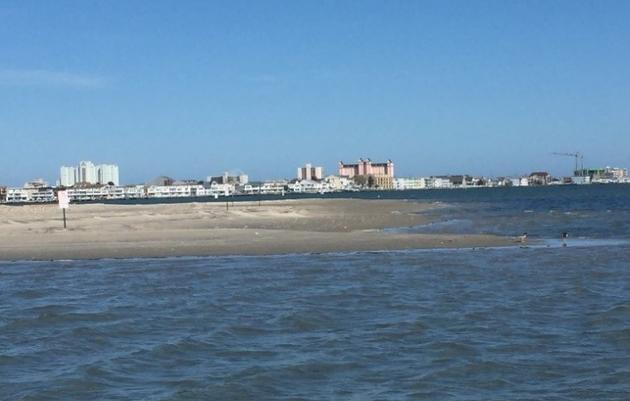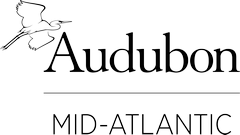OCEAN CITY, Md. (July 20, 2021) – The Maryland Department of Natural Resources (DNR), Audubon Mid-Atlantic, and Maryland Coastal Bays Program are partnering in research and monitoring efforts to preserve three of Maryland’s state endangered colonial nesting waterbirds – the Common Tern, Royal Tern, and Black Skimmer.
As a result of shoreline erosion and sea-level rise in the coastal bays, populations of certain colonial nesting bird species have declined by a staggering 90-95% since the mid-80s. These species typically nest on islands in small colonies on barren beaches. The lack of suitable nesting habitat on these eroding islands has resulted in a loss of sufficient nesting areas for these populations to flourish.
“Island-nesting terns and skimmers in the Coastal Bays are in trouble and are on the cusp of being extirpated – or wiped out – from Maryland as breeding species,” explains Director of Bird Conservation Dr. David Curson of Audubon Mid-Atlantic. “As suitable habitat for these birds dwindles from effects of a changing climate like shoreline erosion and sea-level rise, it’s more important than ever to do what we can to keep them as part of the coastal ecosystem. We need a two-pronged strategy of ongoing sand management to maintain their natural islands to combat erosion, and provide artificial habitat as an interim measure until the species populations are stable again.”
This year the group has undertaken a pilot project to establish an artificial island to imitate the characteristics of an ideal nesting beach for these birds. This project also utilizes a social attraction method that draws in seabirds to the platform with social cues, using bird decoys and audio recordings of birdcalls. This model and technique have proven successful in other parts of the U.S., and in Canada and Europe, including restoring the puffin population in the Gulf of Maine.
Local wood artisans John Collins and Todd Peterson helped to design and construct platforms that were loaded with crushed clam shell for the birds to nest on and anchored in an undisclosed location in the coastal bays. Local community groups constructed chick shelters and decoys were placed to attract Common Terns and Black Skimmers to this new ideal nesting ground.
The nesting platforms will be monitored throughout the season. If this project is successful, then consideration will be given to launching more in the following years to protect and preserve our diminishing colonial waterbird population. Roman Jesien, of the Maryland Coastal Bays Program states, “We hope these nesting platforms work in the short-term while we continue our efforts to restore and conserve our natural islands for the long-term.”
Dave Brinker, Maryland DNR Wildlife and Heritage Service, has been monitoring colonial nesting waterbird populations in Maryland since 1985. “In the late 1980s, there were approximately 3000 pairs of Common Tern and 300 pairs of Black Skimmer nesting in Maryland. Now there are fewer than 5 pairs of Black Skimmer and only 500 pairs of Common Tern that nest in Maryland each summer. The nesting platform project is an attempt to stop this decline and retain nesting terns and skimmers in the Maryland coastal bays.”
Maryland DNR Wildlife and Heritage Service (MD DNR-WHS) is providing technical assistance, materials, and funding through federal Pittman-Robertson funds that the state receives from the U.S. Fish and Wildlife Service. Match for these federal funds comes from Maryland Program Open Space funds used to purchase land for state Wildlife Management Areas and from the Chesapeake Bay and Endangered Species fund (state income tax checkoff). Audubon Mid-Atlantic and Audubon’s Seabird Institute are providing technical support and assistance with planning, coordination, and raft construction under a contract with MD DNR-WHS. Maryland Coastal Bays Program is assisting with planning, coordination, and volunteers.
“The steep population declines in these important bird species warrants our immediate attention,” said Jeannie Haddaway-Riccio, Secretary of the Maryland Department of Natural Resources. “We are pleased to assist with this interim measure as well as long term measures to give them the best possible chance to rebound.”
###
The Department of Natural Resources leads Maryland in securing a sustainable future for our environment, society, and economy by preserving, protecting, restoring, and enhancing the state’s natural resources. DNR manages the state’s public lands and waterways, including its forests, fisheries, parks, and wildlife. Learn more at dnr.maryland.gov.
Audubon Mid-Atlantic is a regional office of the National Audubon Society, which protects birds and their habitats throughout the Americas using science, advocacy, education and on-the-ground conservation. Audubon's state programs, nature centers, chapters and partners have an unparalleled wingspan that reaches millions of people each year to inform, inspire and unite diverse communities in conservation action. Since 1905, Audubon's vision has been a world in which people and wildlife thrive. Audubon is a nonprofit conservation organization. Learn more at www.audubon.org and follow @audubonsociety.
Maryland Coastal Bays Program (MCBP) is one of 28 National Estuary Programs (NEP) across the country that receives EPA funding in order to work toward the restoration and protection of “estuaries of National significance.” The Program is a grassroot, multi-stakeholder collaboration working toward meeting this goal through restoration, science, monitoring, education, and outreach. The coastal bays is one of the most ecologically diverse regions in the state, it supports numerous rare and threatened plant and animal species, forests, and wetlands vital to migratory songbirds and waterfowl, as well as numerous important commercial and recreational fin and shellfish species. Learn more at www.mdcoastalbays.org and follow @MdCoastalBays.
Contact Information:
- Audubon Mid-Atlantic: Chandler Lennon, 804-832-0832, chandler.lennon@audubon.org | David Curson, 410-558-2473, david.curson@audubon.org
- Maryland Department of Natural Resources: Dave Brinker, 410-375-6431, dave.brinker@maryland.gov
- Maryland Coastal Bays Program: Roman Jesien, 410-213-2297, rjesien@mdcoastalbays.org










